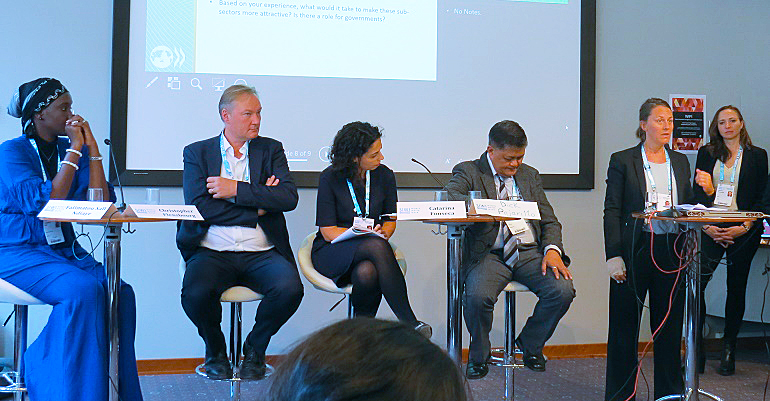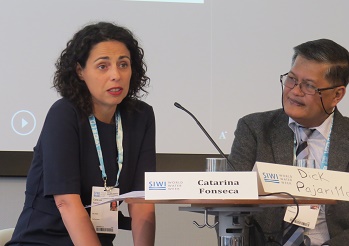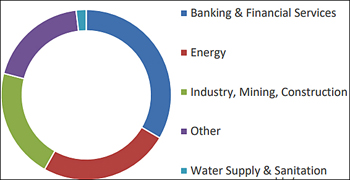SWWW 2018: Potential of blending finance remains untapped for water infrastructure in developing countries

‘In countries as Indian and Ethiopia there is plenty of private finance available for water infrastructure. Investors are hungry’, said Catarina Fonseca, Head Innovation and International Department at IRC Wash, a knowledge-oriented NGO in the Netherlands, at a session on Blended Finance during the Stockholm World Water Week on 27 August.
Financial experts at the session debated the need for the global water sector to attract additional private money – next to fundings from governments and donors, to be able to scale up the projects for more taps and toilets.
Public money alone is considered to be not enough to reach the UN Sustainable Development Goals by 2030. It has been estimated by UNCTAD that between 5 to 7 trillion US dollar is needed to reach the goals, with an investment gap in developing countries of about 2.5 trillion. As governments worldwide are lowering their budgets on development aid, more private money must be mobilized.
 IRC economist Catarina Fonseca mentioned the need for an enabling environment to blend private and public money for water projects in developing countries.
IRC economist Catarina Fonseca mentioned the need for an enabling environment to blend private and public money for water projects in developing countries.
Balancing act
Blending private and public money for a water project is a balancing act and for development banks it can be too time consuming to complete the puzzle and discuss all the financial risks for all project partners.
According to Fonseca there are many factors why the private money cannot be capitalized. One of the most important reasons she considers is the fact that many water service providers are not able to collect water tariffs that cover their costs and are heavily subsidised by governments.
Private financiers consider this a big risk as it does not guarantee that loans can be paid back and politicians can easily decide to stop subsidizing.
But also NGOs and donors can be the disruptors. ‘Sometimes parties have been working on attracting additional private money to provide specific loans for water infrastructure, when another agency decides to provide the money for the same infrastructure as a grant.’, Fonseca noticed.
Several speakers at the session mentioned the lack of an enabling environment for project partners to blend the public and private money. ‘Water projects are often small and complex’, Fonseca explained. ‘There is always a piece of the puzzle missing to come to a financial arrangement. And it often takes too much time to get the last piece in to get the finance up and running’.
 With only 1.9 percent the water sector (light blue) legs far behind in blending finance. The energy sector (red) and the industry (green) are more successful. (source: OECD, 2016)
With only 1.9 percent the water sector (light blue) legs far behind in blending finance. The energy sector (red) and the industry (green) are more successful. (source: OECD, 2016)
Legging behind
Paul Horrocks, Manager for private finance for sustainable development, at the Organisation for Economic Cooperation and Development (OECD) gave some interesting figures on blending finance in different sectors. He referred to a recent OECD-study that showed that in 2012-2015, 81.1 billion US dollar was mobilised from the private sector for development financing. ‘The water sector is letting down with only 1.9 percent’, Horrocks adds.
High potential
The good news from Horrocks was that the water sector has still an enormous potential when it comes to blending finance. He advised to stimulate the creation of local financial markets specially on dealing with the issues of the Sustainable Development Goals. ‘Local financiers are better informed on the capital and operational costs of the proposed water infrastructure’, he said at the session. ‘They better understand who benefits and who takes the real risks.´
The Kenya Innovative Finance Facility for Water (KIFFWA) was mentioned as an example of such a local dedicated facility. KIFFWA is initiated by the Dutch water sector to de-risk Kenyan water projects of more than 2 million euro.
Activities of KIFFWA, that is still in the start-up phase, include the provision of early-stage capital and financial expertise for the creation of viable water investment opportunities and attract (private) investors for viable water projects.
Read also on this website
● Stockholm World Water Week 2018: A look back on an inspiring event to get SDG6 on track, 7 September 2018
● SWWW 2018: Blue deal seeks wisdom on water management from both sides, 6 September 2018
● SWWW 2018: Latest generation water-related apps for small farmers shown at African Spatial Delight, 4 September 2018
● SWWW 2018: Leave no one behind in WASH programmes demands a new mind-set, 3 September 2018
● SWWW 2018: Water.org joins Finish Mondial to team up for affordable toilets worldwide, 31 August 2018
● SWWW 2018: Delft biotech pioneer Mark van Loosdrecht receives Stockholm Water Prize, 30 August 2018
● SWWW 2018: Open data on water availability can prevent that water scarcity leads to conflicts, 29 August 2018
● SWWW 2018: ‘Forge strong partnerships to scale up action’, 28 August 2018
● Meet the Dutch water delegation in the Netherlands pavilion at Stockholm World Water Week (booth 1 )
● Dutch Water Financing Facility adopted as cutting edge climate finance instrument, 29 June 2016
● Smart tax can bridge financial gap to meet universal access to water and sanitation, 17 June 2015
More information
Stockholm World Water Week
www.worldwaterweek.org
IRC Wash
The Hague, the Netherlands
+31 70 3044000
www.ircwash.org
KIFFWA
Nairobi, Kenya
www,kiffwa.com
www.kiffwa.com



